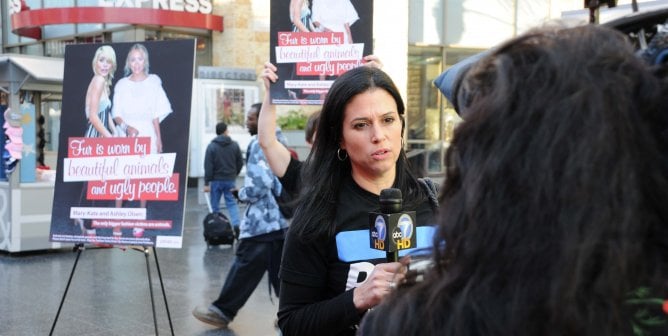Tim Gunn Pens Editorial in Support of Proposed NYC Fur Ban
Style Icon Cites Evolution of Fashion in Push for New York to Join Los Angeles and San Francisco in Banning Fur Sales
For Immediate Release:
May 8, 2019
Contact:
Moira Colley 202-483-7382
Fashion guru Tim Gunn is urging New York City council members to pass a proposed ban on fur ahead of a city hall hearing on May 15. In an editorial on City & State New York, a site followed by New York lawmakers, he cites fur bans by Los Angeles and San Francisco and writes, “There isn’t much to be happy about in politics today, but this trend toward kindness should give everyone hope.”
“[F]urriers used to slice up chimpanzees, gorillas, monkeys, leopards, baby seals, and tigers for their fur,” continues Gunn. “Most of that was declared illegal. Now it’s time to safeguard all the other animals from such gratuitous violence by supporting City Council Speaker Corey Johnson’s bill to ban fur sales in New York.”
Gunn follows in the footsteps of Oscar winner and former fur-wearer Anjelica Huston, who recently penned an op-ed in support of the measure. Numerous top designers and retailers—including many with stores in Manhattan, such as Burberry, Gucci, Versace, Michael Kors, Jimmy Choo, and Giorgio Armani—have already stopped using fur in their collections.
PETA—whose motto reads, in part, that “animals are not ours to wear”—opposes speciesism, which is a human-supremacist worldview. For more information, please visit PETA.org.
Gunn’s editorial follows:
May 8, 2019
Fashion is thriving without fur—let’s protect animals by supporting the proposed ban
By Tim Gunn
Throughout my career—as chair of fashion design at Parsons, creative director at Liz Claiborne, and host of Project Runway—I have advocated against fur.
The fashion business has a troubling history with animals, but it is quickly evolving. Believe it or not, furriers used to slice up chimpanzees, gorillas, monkeys, leopards, baby seals, and tigers for their fur. Most of that was declared illegal. Now it’s time to safeguard all the other animals from such gratuitous violence by supporting City Council Speaker Corey Johnson’s bill to ban fur sales in New York, as lawmakers have already done in Los Angeles and San Francisco. There isn’t much to be happy about in politics today, but this trend toward kindness should give everyone hope.
At Parsons, the fur trade enjoyed years of unchallenged promotion in which it enticed budding designers to work with fur by offering them free fur, trips to Scandinavia, and sponsorship deals. I introduced a program in which PETA was given equal time to screen videos showing what happens to animals on fur farms around the world before their pelts end up in New York showrooms. Foxes, rabbits, chinchillas, and even dogs and cats are anally electrocuted, gassed, bludgeoned, and often skinned alive.
Student interest in the fur program dried up as quickly as enthusiasm for sustainable design increased. Consumer demand for fur has plummeted. According to the treasurer of Greater Fur New York, just 14 retail storefronts selling fur remained in the garment district in 2018—down from 450 in 1977. This year, there are even fewer. Fashion has evolved. Designers are finding it increasingly easy to be creative without being destructive.
When my Project Runway cohort Michael Kors banished fur from his collections, he said, “We now have the ability to create a luxe aesthetic using non-animal fur.” Donatella Versace declared, “Fur? I am out of that. I don’t want to kill animals to make fashion. It doesn’t feel right.” Gucci CEO Marco Bizzarri announced, “Technology is now available that means you don’t need to use fur. The alternatives are luxurious. There is just no need.” Ralph Lauren, Tommy Hilfiger, Armani, and Chanel have enacted fur-free policies, as have dozens of mass-market brands like H&M, Zara, Gap, Nine West, and The North Face.
Style icons are speaking out, too. I hosted a PETA Fashion Week party at Stella McCartney’s Manhattan boutique, during which Taraji P. Henson unveiled her “Rather Go Naked Than Wear Fur” ad. “Could you imagine somebody ripping your hair out, while you’re still awake, fully conscious?” she said. “I don’t think a living being should suffer for the sake of fashion. … We’re advanced as a human race, and there are other things we can do and other products we can use.”
Furthermore, the proposed ban would fit in with the city’s many green initiatives. Fur production requires dangerous chemicals that pollute the environment. To keep animal pelts from putrefying, furriers steep them in pools of noxious chemicals like chromium and formaldehyde. The EPA has fined fur-processing plants for improper disposal of these poisons. A ban on fur sales would boost the burgeoning market for new, greener materials that don’t harm the environment.
Let’s all embrace fabrics that don’t bleed and support Speaker Johnson’s bill to ban fur.


